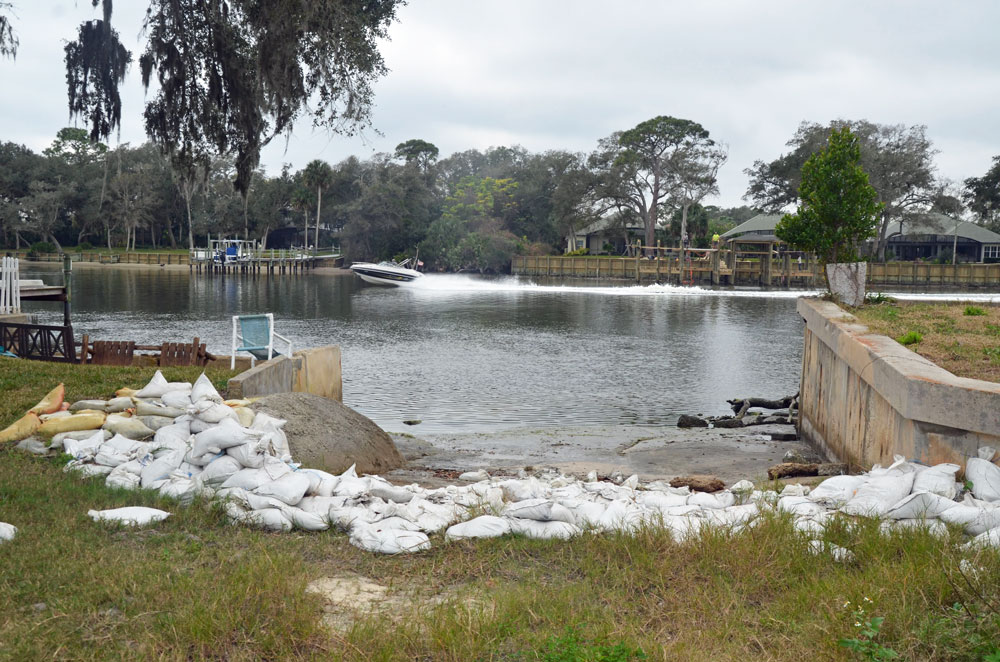
Shirley Nethery was 77, the president of the board at Surfside Estate in Beverly Beach, a volunteer at Flagler Pines, the nursing home, and had retired from AT&T after a 30-year career.
A week before Christmas six years ago, she was driving on lightless Pamela Parkway, a dirt road like any other in a Hammock subdivision but for this difference: except for those familiar enough with the neighborhood to turn onto James Roy Avenue, the road doesn’t end so much as slope down into the Intracoastal through a makeshift boat ramp, without warning. Nethery unknowingly drove into the water and drowned.
The county never addressed the liability. The dirt road and the gaping concrete ramp–a “dedicated roadway” in the county’s verbiage–remain unguarded, without signage, lights or warnings. There’s not so much as a roadside memorial to Shirley.
The ramp is sandwiched between John Dougherty’s property to the south, where his son by the same name lives, and that of Richard Marchewka, a Fort Myers attorney. That house is boarded up and has long been in disuse.
Intracoastal frontage land is very valuable, and in many instances local or state governments go long ways and pay dearly to secure or preserve it. But in early January the county administration sought County Commission approval to split and give away to the adjoining two homeowners the 7,600-odd square feet of right-of-way that constitute the segment of road that continues past James Roy Avenue and into the water. In exchange, the two homeowners would pledge to build a seawall with proper drainage.
The only person to address the commission that day, Dougherty said he was interested in building the seawall to stop his and the neighboring property from being flooded. “Certainly in the interest of the community and the property owners in that community, whatever we do, we’re going to adhere to everybody’s benefit,” he said.
Other residents in the neighborhood had no idea. “We knew nothing about that, nothing, nobody in the neighborhood knew anything about it. Absolutely nothing,” says Krista Grinstead. “No letter to the homeowner notifying us.”
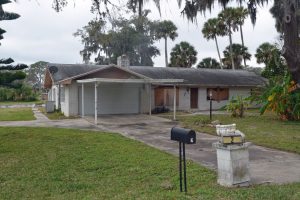
Not unlike many issues that have bumbled through commission votes with little analysis or serious questioning, the county proposal for Pamela Parkway appeared to be heading for quick ratification–until Andy Dance, newly elected to the commission, spoke up. Dance was known on the school board for deliberate and probing analyses. The process had followed the law, he said, but he raised objections about its lack of transparency to residents at large and to the administration’s seeming ad-hoc approach with one such ramp when the issue could set a precedent for several more like it up and down the Intracoastal. He asked that the matter be tabled until February so it could be better studied and visibly advertised. Two other commissioners agreed. Meanwhile Grinstead gathered an online petition and posted a scathing and not-too-kind “rant,” as she herself describing, alleging, without evidence, backroom deal making between one property owner and a commissioner and objecting to the giveaway on other, more community-minded grounds. She retained Dennis Bayer, the Flagler Beach attorney. Dougherty and his family felt unfairly targeted and smeared when they had, in fact, done nothing more than respond to the county reaching out to them with the proposal. Dougherty retained Michael Chiumento, the Palm Coast attorney.
Yet neither side questions the safety hazard. Neither side questions the water problems–though Grinstead says those problems may be exacerbated by the seawall, not abated, since the road now drains like a river into the Intracoastal. Neither side, nor does the county, questions the checkered history of the ramp, which once hosted an illegal dock, rowdy parties and loitering.
And both sides of the homeowner divide agree on one fundamental point that could have avoided the whole conflict.
“This is what we all want,” John Dougherty Jr., who lives at the property, said as he stood on Pamela Parkway at the unmarked turn that Shirley Nethery missed. “We want the county to go ahead, build the seawall, maybe a kayak launch, something like that, that’s still safe and that the whole community can still use. That doesn’t cost us anything, it doesn’t cost him anything,” meaning Marchewka. “Everybody is happy, we still have a community area to use your kayak launch, but a boat ramp obviously doesn’t work here, unless they really built it up, which they’re not going to do because the water’s not deep enough. A kayak ramp would be fine because you’re just walking into the water.”
Bayer sees it the same way. “Let’s work with the neighbors, let’s try to come up with a viable solution for everyone, flood mitigation, public safety and preserve public access at the same time,” he said.
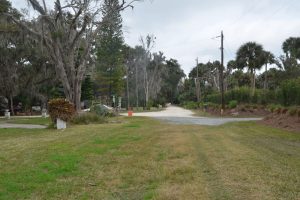
“110 percent would be the idea solution,” Grinstead said. “We have to be careful and it’s a sunup to sundown area, it’s not a late night party area, just like every other county park like Jungle Hut.” In sum, and based even on the way the county administration presented the issue to commissioners in January, the county is punting its responsibility to the two homeowners, alleging that it doesn’t have the money to build the seawall itself. At first sly, the county sought to win approval with little attention. As broader attention caught on, the county’s approach, even if unwittingly, has ended up pitting homeowners against each other, though none of the homeowners are at fault–either for seeking the deal with the county, which even Grinstead says is irresistible from a property owner’s point of view, or for opposing it in the name community ownership of a valuable asset.
“If the county came to me and I lived next to a community land,” Grinstead said, “and they said hey, do you want this land, all you’d have to do is spend $25,000, wouldn’t anybody do that? But is that fair to all the community homeowners who use the boat ramp? No.” She continued: ““I believe 100 percent that the county commissioners are responsible for what’s going on, and I’ll tell you why, as we’ve learned what’s going on here. There are several community boat ramps just like the one we have in our neighborhood. The county doesn’t want to have any responsibility whatsoever with those community boat ramps.”
When Tim Telfer, the county’s resiliency and resource stewardship manager for the county, presented the proposal to the commission in January, he said the homeowners had requested to acquire the parcels to build the seawall–a contention both Dougherty men adamantly dispute. “It’s frustrating, we’re not trying to make any enemies,” the younger Dougherty said. “Basically what happened to us is the county reached out to us, said hey, your neighbor is going to try and take 50 feet but we wanted to give you the option to take 25 feet.”
Telfer noted the flooding of the two homes during Hurricane Matthew and Irma, and the high water in others’ yards, though during Matthew the higher water flooded in from the east, when it demolished the dune system the county spent $25 million repairing. (The seawall at the property would cost between $25,000 and $60,000.)
“With regard to the loss of public access it’s absolutely a fact and we have it at probably a half dozen similar situations up and down the Intracoastal Waterway here,” Telfer said. “At the end of the day, we try to balance the liability the county has in these circumstances versus the potential future benefit. At the end of the day, I can only speak for this item, not all of them, and in this item we felt it had merit to consider a vacation at this time.” (The technical term for the county giving away a public right of way is “vacating” it.)
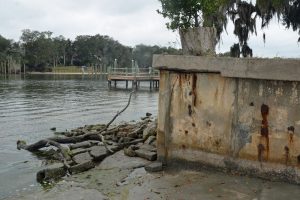
Dance vitiated the location, as did Commissioner O’Brien and, previously, Greg Hansen, whom a neighbor invited over two years ago to discuss the issue (the resident was interviewed but asked not to be named, a reflection of the sensitivity of the issue among some neighbors). Hansen was ill the day the commission discussed the ramp. Dance doesn’t question the various problems that attach to the boat ramp, calling the current status “unacceptable.” It’s no small matter, too, that the northern property encroaches on the right of way by about 15 feet, going back to a previous owner’s presumptive construction. He then questioned the county’s method. “In many municipalities they go the extra distance and put a lot more process into vacating right of ways,” he said. “So we’re proceeding with the acceptance of the two property owners. But it hasn’t been noticed to the remainder of the platted area that has access to it.” He referred to “a half dozen other pieces just like this along the Intracoastal Waterway” that the county administration should study whole before doing a “vacation” piecemeal. “We could get rid of a problem that I think has been a thorn on the county’s side for a while. But my objections are with the public notice, and I think we need to take a view a few thousand feet up, and not just focus on this one parcel, but look at all the parcels in total.”
His motion included direction that, if the seawall was to be built, the “vacation” would preserve a drainage easement. Telfer had actually recommended that. He’d been overruled by Cameron, the county administrator. “My idea on these pieces of right of way that never reach their intended use become liabilities,” Cameron said, “and to return it to exactly the condition of all the other properties along there is the safest way out for the county. But I do believe that Mr. Telfer’s argument about easements is one that reasonable men differ on.” Dance stood by his original intent, which got the majority vote, with Joe Mullins the one dissenter.
When the commission takes up the Pamela Parkway issue again on Monday, it’ll see essentially the same proposal it saw in January, with the ordinance vacating the land. The four options the administration is presenting include approval, approval with condition, denial or another delay. There is no option that would have the county do what all residents want it to do: assume responsibility for the ramp and build the necessary mitigation.
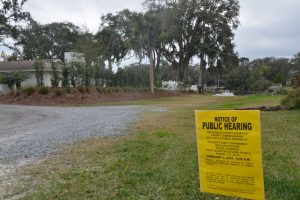
“It seems to me we shouldn’t be giving up a public access to our waterways and natural resources, particularly not to neighboring property owners. It’s a pretty valuable piece of property,” Bayer said, placing the value at around $6,000 a linear foot, based on his recent research. Even if the county doesn’t want to spend the money–a small sum, relatively speaking, Bayer said–there are other options, such as the applying for grants through the Florida Inland Navigation District, an agency that collects taxes from Flagler residents. (The late Jon Netts, the former mayor of Palm Coast, was a long-time member of FIND, and channeled $2 million in grants to Flagler projects in his time there.) “FIND provides grants for this type of thing all the time–they provide grants for public access to waterways,” Bayer said. “This doesn’t have to be a big full-on boat ramp. There are a couple of them by my house, a bench and a place where you can launch a kayak and that’s about it.”
He equated vacating with punting. “If they vacate the right of way, that’s what they’re doing,” he said. “To me it sets a dangerous precedent because there’s other rights of way in the hammock or other parts of the county where landowners can request the same thing. We’re spending all this money to try to acquire access to waterways and natural resources, on the other hand we’re giving it away.”
![]()





























snapperhead says
“When Tim Telfer, the county’s resiliency and resource stewardship manager for the county, presented the proposal to the commission in January,”
Can someone tell me what a resiliency and resource stewardship manager does for 40+ hours a week? And should I assume since the title is manager he directs a staff?
Jane Gentile-Youd says
That ramp belongs to the residents of Flagler County not the county attorney or any other county employee to barter, to sell, nor to ‘gift’ to anyone. Mr. Hadeed’s undeserved salary of $222,000 should cover the cost of
repairing public property for the benefit of the taxpayers and local residents.
Time for legal zoom in my opinion. Hadeed sure knows what to do with county property – very recently the old sheriff’s building was given away for under $900,000 to investors who have it listed now for $3.5 million.
What giveaway is next? County Hall? Oh but I believe it has been given away also.. don’t you agree?
ASF says
Because, as we all know the good people of the Hammock own Palm Coast–or they think they do. Nothing goes ahead without their approval and everything they want that improve improve their own property values must passed automatically at county expense. Change is good if THEY say so.
Stable Genius says
Have we actually had a qualified professional engineer evaluate the situation and determine the costs/merits of each option? No, but Cameron looked into it. Cameron did an internship with the forestry service or something similar when he was a teen; what is the difference between that and the normal process of becoming an engineer? If you ask him, he might tell you about his expertise in engineering, hydraulics, or even hydrology. If you ever need a second opinion about heart surgery or want to know how to build a rocket ship, you might want to get his opinion.
Chris S. says
So… the county put sandbags to prevent flooding from the river. When the break wall goes up, where is the water from the street going to drain to? Are the 2 owners responsible for flooding the other properties and take responsibility for the street drainage?; and liability for any flood damage?
In the least, the county has responsibility to chain off the street, clean up the debris and put in a street light. Obviously it doesn’t want to do that and just pawn the problems on 2 neighbors. Remember the county contacted them. I assume being just a right of way, the 2 owners actually own the property and if the right of way was not there, both properties would look different and any drainage issues would have been solved 100 years ago.